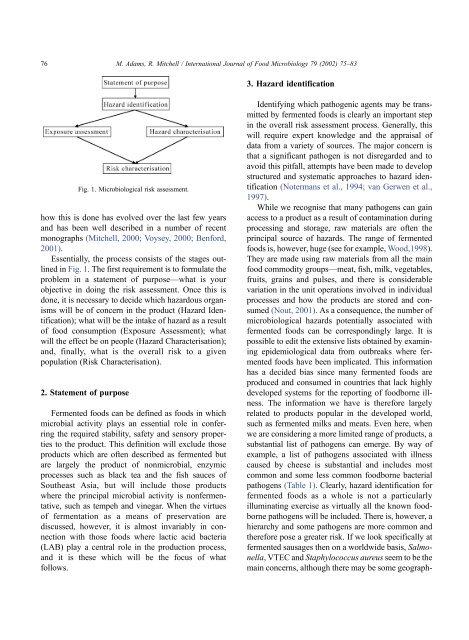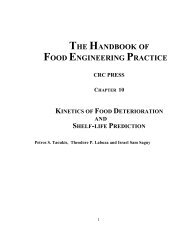Fermentation and pathogen control: a risk assessment approach
Fermentation and pathogen control: a risk assessment approach
Fermentation and pathogen control: a risk assessment approach
Create successful ePaper yourself
Turn your PDF publications into a flip-book with our unique Google optimized e-Paper software.
76M. Adams, R. Mitchell / International Journal of Food Microbiology 79 (2002) 75–833. Hazard identificationFig. 1. Microbiological <strong>risk</strong> <strong>assessment</strong>.how this is done has evolved over the last few years<strong>and</strong> has been well described in a number of recentmonographs (Mitchell, 2000; Voysey, 2000; Benford,2001).Essentially, the process consists of the stages outlinedin Fig. 1. The first requirement is to formulate theproblem in a statement of purpose—what is yourobjective in doing the <strong>risk</strong> <strong>assessment</strong>. Once this isdone, it is necessary to decide which hazardous organismswill be of concern in the product (Hazard Identification);what will be the intake of hazard as a resultof food consumption (Exposure Assessment); whatwill the effect be on people (Hazard Characterisation);<strong>and</strong>, finally, what is the overall <strong>risk</strong> to a givenpopulation (Risk Characterisation).2. Statement of purposeFermented foods can be defined as foods in whichmicrobial activity plays an essential role in conferringthe required stability, safety <strong>and</strong> sensory propertiesto the product. This definition will exclude thoseproducts which are often described as fermented butare largely the product of nonmicrobial, enzymicprocesses such as black tea <strong>and</strong> the fish sauces ofSoutheast Asia, but will include those productswhere the principal microbial activity is nonfermentative,such as tempeh <strong>and</strong> vinegar. When the virtuesof fermentation as a means of preservation arediscussed, however, it is almost invariably in connectionwith those foods where lactic acid bacteria(LAB) play a central role in the production process,<strong>and</strong> it is these which will be the focus of whatfollows.Identifying which <strong>pathogen</strong>ic agents may be transmittedby fermented foods is clearly an important stepin the overall <strong>risk</strong> <strong>assessment</strong> process. Generally, thiswill require expert knowledge <strong>and</strong> the appraisal ofdata from a variety of sources. The major concern isthat a significant <strong>pathogen</strong> is not disregarded <strong>and</strong> toavoid this pitfall, attempts have been made to developstructured <strong>and</strong> systematic <strong>approach</strong>es to hazard identification(Notermans et al., 1994; van Gerwen et al.,1997).While we recognise that many <strong>pathogen</strong>s can gainaccess to a product as a result of contamination duringprocessing <strong>and</strong> storage, raw materials are often theprincipal source of hazards. The range of fermentedfoods is, however, huge (see for example, Wood,1998).They are made using raw materials from all the mainfood commodity groups—meat, fish, milk, vegetables,fruits, grains <strong>and</strong> pulses, <strong>and</strong> there is considerablevariation in the unit operations involved in individualprocesses <strong>and</strong> how the products are stored <strong>and</strong> consumed(Nout, 2001). As a consequence, the number ofmicrobiological hazards potentially associated withfermented foods can be correspondingly large. It ispossible to edit the extensive lists obtained by examiningepidemiological data from outbreaks where fermentedfoods have been implicated. This informationhas a decided bias since many fermented foods areproduced <strong>and</strong> consumed in countries that lack highlydeveloped systems for the reporting of foodborne illness.The information we have is therefore largelyrelated to products popular in the developed world,such as fermented milks <strong>and</strong> meats. Even here, whenwe are considering a more limited range of products, asubstantial list of <strong>pathogen</strong>s can emerge. By way ofexample, a list of <strong>pathogen</strong>s associated with illnesscaused by cheese is substantial <strong>and</strong> includes mostcommon <strong>and</strong> some less common foodborne bacterial<strong>pathogen</strong>s (Table 1). Clearly, hazard identification forfermented foods as a whole is not a particularlyilluminating exercise as virtually all the known foodborne<strong>pathogen</strong>s will be included. There is, however, ahierarchy <strong>and</strong> some <strong>pathogen</strong>s are more common <strong>and</strong>therefore pose a greater <strong>risk</strong>. If we look specifically atfermented sausages then on a worldwide basis, Salmonella,VTEC <strong>and</strong> Staphylococcus aureus seem to be themain concerns, although there may be some geograph-














